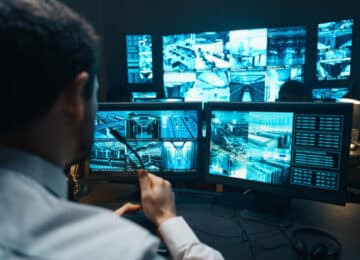CCTV in stores: How long are the videos kept for?

With the rise in shoplifting, many businesses are now using video surveillance to protect their stores. Whether the store has one or multiple cameras, there are rules regarding the retention period for keeping recorded images. What is the maximum period? What happens in the event of legal proceedings?
What are video surveillance images used for?
In a store, video surveillance devices have a double advantage. They firstly allow for the collection of images that provide proof of shoplifting. Combined with AI, they also offer the possibility of quick intervention when a shoplifter is caught in the act.
Images as evidence
The images recorded by surveillance cameras can be used to confront a suspected shoplifter. The head of security can show them the images to evidence the criminal act. This evidence is also admissible in the event of charges being pressed and legal action being taken.
Data to be analysed in respect of customers’ privacy
The AI will also uses these images to detect shoplifting gestures. Effectively, thanks to this technology, a store’s security agents can be notified when shoplifting is in progress. The manager receives a video alert as soon as the AI detects an anomaly. They can then quickly intercept the suspect. The AI can be used even if the store only has one surveillance camera. It should be noted that, in regard to the Veesion software, the AI does not use facial recognition. Customers’ privacy is therefore protected.
It should also be noted that stores, which are public places, must comply with the regulations on video surveillance.
Recommendations on video surveillance in stores
This regulation aims to protect the privacy of customers and to reinforce their right of information regarding the processing of their personal data.
According to the CNIL
On the CNIL website, retailers can find all of the rules and precautions to be taken into account regarding the installation of surveillance cameras in their stores, including:
- How to submit a prior declaration to the prefecture;
- How to install the cameras (and which locations are prohibited, such as toilets and changing rooms);
- Who is authorised to view the images;
- How to inform the store’s customers.
Maximum retention period for images acquired through video surveillance in stores
According to the CNIL website, the data controller of the images defines the retention period for this data. However, this retention period must not exceed 30 days. Images used as evidence in legal proceedings are subject to a different process.
What happens when images are used in legal proceedings?
The CNIL specifies that a few days of retention are sufficient to carry out verifications following an incident. However, charges must first be filed with the relevant public prosecutor (either by letter or by reporting it in a police station).
The retailer victim to the shoplifting, considered to be simple theft under the terms of the law, may also establish itself as a plaintiff claiming damages and interest. When legal proceedings are initiated, the images constituting evidence are extracted from the video surveillance device and are retained until the end of these proceedings.
To conclude, the image recordings from the video surveillance system constitute data, the use of which must comply with the applicable regulations. An individual must be designated as being in charge of its processing. These recordings may be used as evidence following a shoplifting incident. In this case, they are extracted from the device and stored within the context of proceedings. If no incident is found to have conclusively taken place, the images may not be retained for more than 30 days, in order to respect the privacy of the store’s customers.



